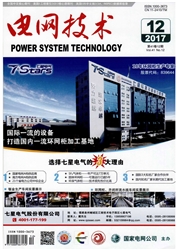

 中文摘要:
中文摘要:
针对实测相量量测单元(phasor measurement unit,PMU)数据存在随机量测噪声甚至不良偏差数据,导致线路参数辨识精度降低;不同线路量测误差不同导致算法适应性差的实际问题,提出了一种线路零序参数在线自适应抗差辨识方法:首先,建立了单回线、同杆并架双回线零序参数辨识模型,并基于线路两侧零序电压、电流相量数据构建了单回线/同杆并架双回线线路方程,对方程进行虚实部解耦,形成传统最小二乘辨识模型所需线性关系;其次,将结合期望和标准差的中位数估计的自适应"三段式"IGG(Institute of Geodesy&Geophysics,Chinese Academy of Sciences)抗差最小二乘法应用于零序参数辨识,其可自动将量测数据划为保权的正常数据、降权的可疑数据和弃用的淘汰数据,实现不同误差情况下的自适应抗差辨识;再次,采用单相跳闸后至重合闸成功之前这一时段的数据完成输电线路零序参数在线辨识,并给出了适应单回线和双回线的零序参数辨识方案;最后,仿真验证了所提方案的抗噪及抗差能力,并通过采用PMU实测数据的实际单回线、同杆并架双回线零序参数辨识,说明了文中方法的工程实用性。
 英文摘要:
英文摘要:
Line parameter identification methods with phasor measurement unit(PMU) data may lead to bad result due to random measurement noise, even bad data deviation among the data, and it may have poor adaptability due to different error levels in field data. To solve above problems, this paper proposes an adaptive online robust identification scheme for zero sequence parameters of transmission lines. Firstly, zero sequence parameter identification models and equations based on phasor data of zero sequence voltage and current obtained at both terminals of single-circuit line or double-circuit lines on the same tower are established. The equations are decoupled into imaginary and real parts, forming linear equation for the least square identification model. Secondly, adaptive "three stages" Institute of Geodesy Geophysics, Chinese Academy of Sciences(IGG) robust identification method combining median estimates of expectation and variance is applied to obtain adaptability and robustness of the identification method for zero sequence parameters. The proposed method can adaptively divide field data into normal data with retained weight, suspicious data with reduced weight and discarded data. Thirdly, the data between single-phase tripping and successful reclosing are used to calculate zero sequence components and parameters. Furthermore, the identification scheme for zero sequence parameters of single- and double-circuit lines is proposed. Simulation results validate effectiveness of the proposed scheme and anti-noise and robust ability of the proposed methods. Engineering practicability of the proposed method is verified with filed data of single- and double-circuit lines.
 同期刊论文项目
同期刊论文项目
 同项目期刊论文
同项目期刊论文
 期刊信息
期刊信息
